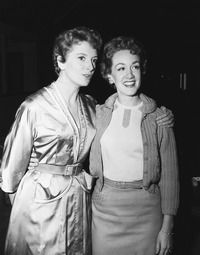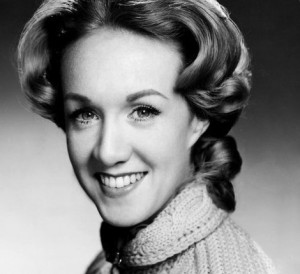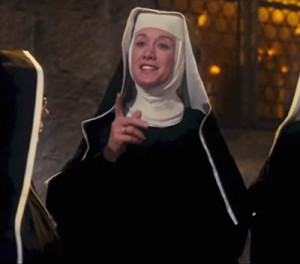The Ghosts of Hollywood Past: Marni Nixon
January 13, 2022

By Allie Little
Marni Nixon was an actress that performed in some of the most beloved movies of the 50s and 60s, but not in the traditional sense. Stunningly beautiful and immensely talented, Nixon might not be well-known to the general film audience due to the fact that she did not actually appear on screen. Rather than working beside names like Marilyn Monroe, Audrey Hepburn, Deborah Kerr, and Natalie Wood, Nixon was featured behind these women. Marni Nixon made her living by being a ghost singer.
While the act of dubbing stars has gone entirely out of fashion in Hollywood today, this was a common practice during the Golden Age of Hollywood movie musicals. The goal of Hollywood and movies in the time after World War II was to create a fantasy. They wanted to sell a perfect world filled with beautiful people and expensive destinations. Everything and everyone had to be flawless. Think of some of the biggest stars of the 50s and 60s: Jimmy Stewart, Cary Grant, Grace Kelly, Ingrid Bergman. These performers were known so well for their portrayal of charming, high-class characters that it became a part of their star persona. For example, after appearing in The Bells of St. Mary (1945) and Joan of Arc (1948), Ingrid Bergman was labeled a saint by a large portion of the film audience, and then practically exiled out of the country after the reveal of her involvement in an affair (more on that in a future blog). Alternatively, Grace Kelly’s eventual marriage to the Prince of Monaco in 1956 made her an actual princess, leaving many people wondering how she wasn’t one all along. Marni Nixon’s show business career rapidly expanded during this era of Hollywood fantasy, and her voice would be utilized by the biggest stars in the business.
Nixon’s dubbing career began in 1949’s The Secret Garden, but would really take off after she sang parts for Marliyn Monroe in her legendary performance of “Diamonds are a Girl’s Best Friend.” While Monroe’s vocals are perfect for her sultry blonde persona (see the 1959 film Some Like It Hot for some of her best performances), her voice naturally fits in a lower register. With a 4-octave vocal range, perfect pitch, and ability to mimic others’ styles flawlessly, Marni Nixon was brought in by the studio to help with notes that were an octave or two above Monroe’s range. Folks that didn’t know there were two singers would never guess, and the studio got to keep Marilyn Monroe’s image as a perfect performer intact. Marni would receive no credit for her work on the movie, but that was always part of the deal. In her own words:
 “I had to sign, with all the dubbing things, that nobody should ever know. Actually the studio . . . called me, and they said that if anyone ever knew that I did any part of the dubbing, that they would see to it that I wouldn’t work in town again.”
“I had to sign, with all the dubbing things, that nobody should ever know. Actually the studio . . . called me, and they said that if anyone ever knew that I did any part of the dubbing, that they would see to it that I wouldn’t work in town again.”
Marni was spectacular at pulling off near-flawless impressions, but the degree at which the dubbing was successful was dependent on the actress on screen. One of Marni’s most successful collaborations was her work with Deborah Kerr on the King and I (1956). The two performers would spend hours together as Marni worked on perfecting Kerr’s British accent, mannerisms, and tonal quality. Eventually, the two would enter the sound booth together, and Marni recorded each song before the movie began filming. Deborah would then lip sync to the recording during filming. Because of Kerr’s willingness to work with Nixon, the result in the film is incredibly convincing. The tone and accent are identical to Kerr’s speaking voice throughout the film.
Deborah Kerr’s openness to being dubbed did not stop after the movie quit filming. On the press tour for The King and I, Kerr would openly speak about Marni and their collaboration on the film. Dubbing was seen as an industry secret at the time, and no actor had publicly spoken on the matter. In a 1956 interview with the Mirror News titled “Deborah Tells a Secret,” Kerr mentioned working with Marni Nixon on the songs for the movie. After being asked why she didn’t sing the songs alone, Kerr responded with “I can’t!” After this interview, Nixon wasn’t sure what would come of her career. She was still under the impression that no studio would hire her if the secret got to the press. However due to Kerr’s professionalism and confidence in the film’s quality, it actually ended up helping Nixon’s career. The two would work together again the following year in An Affair to Remember (1957).
Kerr was, in many ways, the perfect collaborator, but many of Nixon’s next jobs weren’t as smooth sailing. The film adaptation of West Side Story (1961) would be her next notable performance behind the screen. Most of the cast were smaller names in Hollywood, chosen mostly for their dancing or gymnastics abilities. The one exception to this was the film's female lead, Natalie Wood. Having starred in Rebel Without a Cause (1955) and All the Fine Young Cannibals (1960), Wood was one of the biggest young actresses in Hollywood before being cast as Maria in West Side Story. During pre-production, Wood spent time preparing her voice in order to sing the incredibly challenging soprano parts required by Maria in the film. She was under the impression that her voice would be used for most of the film, and Nixon would be there to dub any of the dramatic high notes. What the actress didn’t know was that the studio never planned to use her recordings in the film. Reportedly, it wasn’t until the last day of production that Wood found out she would be entirely dubbed over for the final product. Nixon recorded everything without the help from Wood, and the movie suffers for it. Unlike in The King and I, it is easier to see that Wood was recorded over while watching this film.
Following West Side Story, Marni moved on to another film that caused controversy for its use of dubbing. 1964’s My Fair Lady chose to cast Audrey Hepburn in the leading role instead of the actress who originated the role on the stage, Julie Andrews. Andrews was a newcomer to the world of film acting, but many (including herself) thought she would play Eliza Doolittle in the film version because of her familiarity with the character. On the contrary, Warner Bros. Studio assumed casting Audrey Hepburn would bring in a much higher profit because of her success in movies like Breakfast at Tiffany’s (1961) and Roman Holiday (1953).The only problem with this idea was that Audrey Hepburn was not a singer and because of this, Warner Bros. hired one.Similar to Natalie Wood in West Side Story, Audrey worked with a vocal coach and prepared immensely for her performance as Eliza. Marni Nixon was again hired to dub over Hepburn’s original performance without her knowledge.
Many people speculated that because Hepburn didn’t sing the part, she was snubbed an Academy Award Nomination. Instead, an actress still seen as a newcomer won the Best Actress award that year for her debut film role: Julie Andrews as Mary Poppins. Not only did Andrews win the Oscar that year, but she also won a Golden Globe and BAFTA. In her Golden Globe speech, she threw a slight jab at the head of Warner Bros Studio, Jack Warner, for not casting her in the movie adaption of My Fair Lady.
“My thanks to a man who made a wonderful movie and who made all this possible in the first place, Mr. Jack Warner.”
 One final glimpse into the career of Marni Nixon was her role in The Sound of Music (1965). Don’t worry, I’m not going to ruin the movie and tell you Julie Andrews was dubbed while singing for Maria. Andrews performed that role all herself and gave one of the greatest performances of her career. Instead of dubbing for the lead, Marni got to sing her own words for a change. As Sister Sophia, Nixon sang on songs such as “Maria” and got to stretch her acting muscles in many of the scenes at the Abbey. This film marked one of the only times that the world got to see the charm and talent of Marni Nixon, herself.
One final glimpse into the career of Marni Nixon was her role in The Sound of Music (1965). Don’t worry, I’m not going to ruin the movie and tell you Julie Andrews was dubbed while singing for Maria. Andrews performed that role all herself and gave one of the greatest performances of her career. Instead of dubbing for the lead, Marni got to sing her own words for a change. As Sister Sophia, Nixon sang on songs such as “Maria” and got to stretch her acting muscles in many of the scenes at the Abbey. This film marked one of the only times that the world got to see the charm and talent of Marni Nixon, herself.
On December 10, 2021, Steven Spielberg released a new version of West Side Story. Where the original 1961 film cared little for accuracy (hiring actors based more on their physical abilities rather than ethnic authenticity), Spielberg wanted to have proper representation. He made it his goal to hire performers that were singers, actors, and accurate representations of the communities portrayed on screen. (In addition to hiring singers to dub the actors, the original film hired nearly an entirely white cast to play the Puerto Rican characters.) Spielberg’s version of West Side Story illustrates a melding of fantasy and reality that Hollywood is finally bringing together. This new Hollywood is a place the Marni Nixon”s of the world are now acting in front of the camera, instead of hidden behind the scenes.